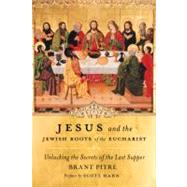
Note: Supplemental materials are not guaranteed with Rental or Used book purchases.
Purchase Benefits
What is included with this book?
| Foreword | p. ix |
| Introduction | p. 1 |
| The Mystery of the Last Supper | |
| Jesus and Judaism | p. 11 |
| You Shall Not Drink the Blood | p. 13 |
| Through Ancient Jewish Eyes | p. 17 |
| What Were the Jewish People Waiting For? | |
| What Kind of Messiah? | p. 22 |
| The Jewish Hope for a New Exodus | p. 23 |
| Jesus and the New Exodus | p. 42 |
| The New Passover | |
| The Biblical Roots of Passover | p. 50 |
| What Was Passover Like at the Time of Jesus? | p. 59 |
| Jesus and the New Passover | p. 68 |
| You Have to Eat the Lamb | p. 74 |
| The Manna of the Messiah | |
| The Manna in the Tabernacle | p. 78 |
| The Bread of the World to Come | p. 86 |
| Jesus and the New Manna | p. 92 |
| ôThis Is a Hard Sayingö | p. 104 |
| The Bread of the Presence | |
| The Bread of the Face | p. 118 |
| ôBehold, God's Love for Youö | p. 125 |
| Jesus and the New Bread of the Presence | p. 134 |
| The Real Presence | p. 144 |
| The Fourth Cup and the Death of Jesus | |
| The Shape of the Jewish Passover Meal | p. 149 |
| Did Jesus Finish the Last Supper? | p. 158 |
| I Thirst | p. 165 |
| The Jewish Roots of the Christian Faith | |
| Pascha Means Passover | p. 172 |
| The Shadow of the Manna | p. 180 |
| In Remembrance of Me | p. 188 |
| On the Road to Emmaus | |
| Acknowledgments | p. 203 |
| Notes | p. 205 |
| Table of Contents provided by Ingram. All Rights Reserved. |
The New copy of this book will include any supplemental materials advertised. Please check the title of the book to determine if it should include any access cards, study guides, lab manuals, CDs, etc.
The Used, Rental and eBook copies of this book are not guaranteed to include any supplemental materials. Typically, only the book itself is included. This is true even if the title states it includes any access cards, study guides, lab manuals, CDs, etc.